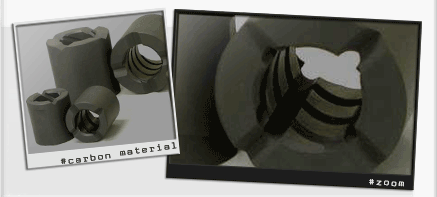
Product Introduction
We are the only seal manufacturer in the world that produces carbon in-house.
The general characteristics of carbon are "small thermal expansion", "large thermal conduction", "strong against thermal shock", "high heat resistant temperature", "self-lubricating", "light", and "light". It has excellent chemical resistance. ”
We have various grades of carbon as shown below, and we use them properly according to the specifications and applications.
We are also researching and developing higher performance carbon.
The general characteristics of carbon are "small thermal expansion", "large thermal conduction", "strong against thermal shock", "high heat resistant temperature", "self-lubricating", "light", and "light". It has excellent chemical resistance. ”
We have various grades of carbon as shown below, and we use them properly according to the specifications and applications.
We are also researching and developing higher performance carbon.
Example of using carbon bearings
Our company, which researches and develops carbon in-house, possesses carbon with various characteristics. We can also handle products with short delivery times by controlling our own processes. If possible, we also accept trial production.
TANKEN CARBON PROPERTIES
Material code | Composition | Permeability | proportion | Hardness (Hs) | Flexural strength (N / mm2) | Compression strength (N / mm2) |
B11* | Carbon graphic Non-impregnation | Penetration | 1.68 | 70 | 55 | 135 |
B30* | Carbon graphic Resin impregnation | Impervious | 1.77 | 75 | 65 | 165 |
B40* | Carbon graphic Resin impregnation | Impervious | 1.77 | 75 | 65 | 165 |
C10* | Carbonaceous Non-impregnation | Penetration | 1.72 | 90 | 63 | 165 |
C20* | Carbonaceous Non-impregnation | Impervious | 1.77 | 105 | 73 | 250 |
C30* | Carbonaceous Resin impregnation | Impervious | 1.77 | 100 | 73 | 250 |
C40* | Carbonaceous Resin impregnation | Impervious | 1.77 | 100 | 73 | 250 |
E11* | Carbonaceous Non-impregnation | Penetration | 1.45 | 105 | 80 | 250 |
F10* | Carbonaceous Impregnation | Penetration | 1.75 | 105 | 93 | 350 |
F40 | Carbonaceous Resin impregnation | Impervious | 1.85 | 110 | 103 | 400 |
F60* | Carbon graphic Non-impregnation | Minor | 1.78 | 100 | 90 | 280 |
F70* | Carbon graphic Non-impregnation | Impervious | 1.85 | 106 | 103 | 300 |
F90* | Carbon graphic Resin impregnation | Impervious | 1.83 | 110 | 110 | 330 |
V21 | resin bonds | Penetration | 1.85 | 20 | 22 | 14 |
V23 | resin bonds | Impervious | 1.95 | 30 | 30 | 1.9Note) 4 |
Material code | Young's modulus (× 103N / mm2) | Poisson's ratio | Coefficient of thermal expansion (× 10-6 / K) | Thermal conductivity (W / m ・ K) | specific heat (× 103J / Kg ・ K) | In the air Eur-lex.europa.eu eur-lex.europa.eu (℃) |
B11* | 10 | 0.2 | 4 | 12 | 0.7 | 350 |
B30* | 12 | 0.2 | 5 | 15 | 0.7 | 250 |
B40* | 12 | 0.2 | 5 | 15 | 0.7 | 250 |
C10* | 14 | 0.2 | 5 | 4 | 0.7 | 350 |
C20* | 17 | 0.2 | 6 | 5 | 0.7 | 350 |
C30* | 17 | 0.2 | 6 | 5 | 0.7 | 250 |
C40* | 17 | 0.2 | 6 | 5 | 0.7 | 250 |
E11* | 23 | 0.2 | 4 | 5 | 0.7 | 350 |
F10* | 40 | 0.3 | 6 | 5 | 0.7 | 350 |
F40 | 40 | 0.3 | 7 | 7 | 0.7 | 250 |
F60* | 18 | 0.2 | 6 | 4 | 0.7 | 350 |
F70* | 20 | 0.3 | 7 | 7 | 0.7 | 350 |
F90* | 20 | 0.3 | 7 | 4 | 0.7 | 250 |
V21 | 1.9Note) 4 | - | // 23.0 ⊥ 33.0Note) 5 | 4 | - | 230 |
V23 | 2.2 | - | // 23.0 ⊥ 33.0Note) 5 | 4 | - | 200 |
Note 4) The stress when the strain amount is 5% (the stress at which, when at 20 ° C, 5% strain occurs) is displayed.
Note 5) ⊥: Axial direction, //: Radial direction.
Note 5) ⊥: Axial direction, //: Radial direction.
Carbon with excellent wear resistance
C20・C40・E11・F10・F70・F90
Carbon with excellent blister resistance
C20 / F70 / F90
Carbon with excellent dry resistance
F60 / F70 / F90 / V21 / V23
Carbon with excellent corrosion resistance
C20 / F70 / F90
C20・C40・E11・F10・F70・F90
Carbon with excellent blister resistance
C20 / F70 / F90
Carbon with excellent dry resistance
F60 / F70 / F90 / V21 / V23
Carbon with excellent corrosion resistance
C20 / F70 / F90


